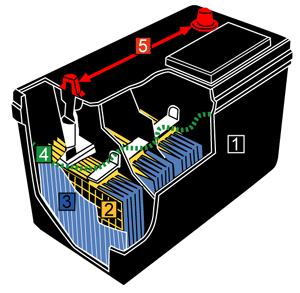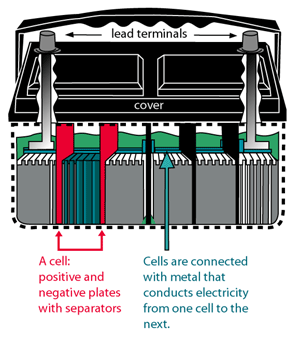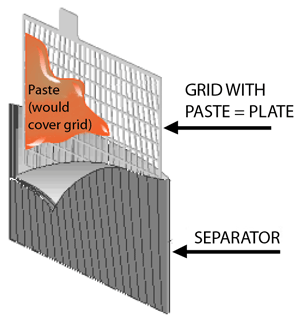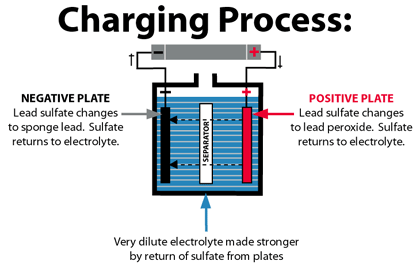
Batteries are made of five basic components:
- A container made of plastic.
- Positive and negative internal plates made of lead.
- Separators made of porous synthetic material.
- Electrolyte, a dilute solution of sulphuric acid and water better known as battery fluid.
- Lead terminals, the connection point between the battery and whatever it powers.

The manufacturing process begins with the production of a plastic container and cover. Most automotive battery containers and their covers are made of polypropylene. For a typical 12-volt car battery, the case is divided into six sections, or cells shaped somewhat like one row in an ice-cube tray. The cover will be sealed to the top of the container when the battery is finished.
The process continues with the making of grids or plates from lead or an alloy of lead and other metals. A battery must have positive and negative plates to conduct a charge.
Next, a mud-like paste mixture of lead oxide powder, sulphuric acid, and water (plus a small number of additives depending on whether the paste is for positive or negative plates) is applied to the grids.
Inside the battery, the pasted positive and negative plates must be separated to prevent short circuits. Separators are thin sheets of porous, insulating material used as spacers between the positive and negative plates. Fine pores in the separators allow electrical current to flow between the plates while preventing short circuits.

In the next step, a positive plate is paired with a negative plate and a separator. This unit is called an element, and there is one element per battery cell or compartment in the container. Elements are dropped into the cells in the battery case. The cells are connected with a metal (usually lead) that conducts electricity. The terminals, or posts, (usually made of lead) are welded on.

The battery is then filled with electrolyte – or battery fluid – a mixture of sulphuric acid and water, and the cover is attached.
The final step is charging, or finishing. During this step, the battery terminals are connected to a source of electricity and the battery is charged for many hours. During this process, the paste in the positive plate is converted to a different form of lead oxide and the paste in the negative plate is converted to spongy lead. When the battery is fully charged, the battery is cleaned, the labels are attached and it is packaged ready for transport.